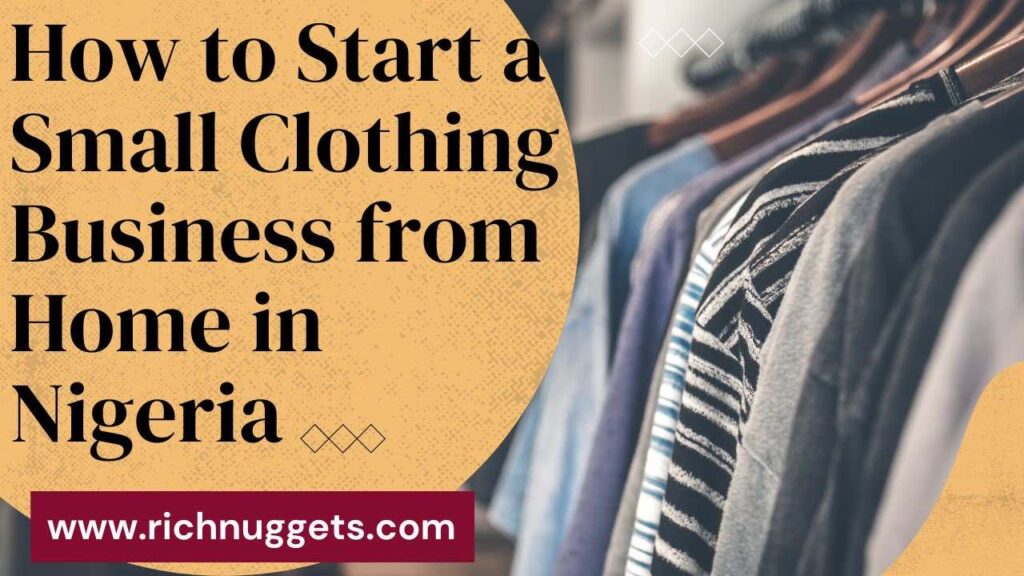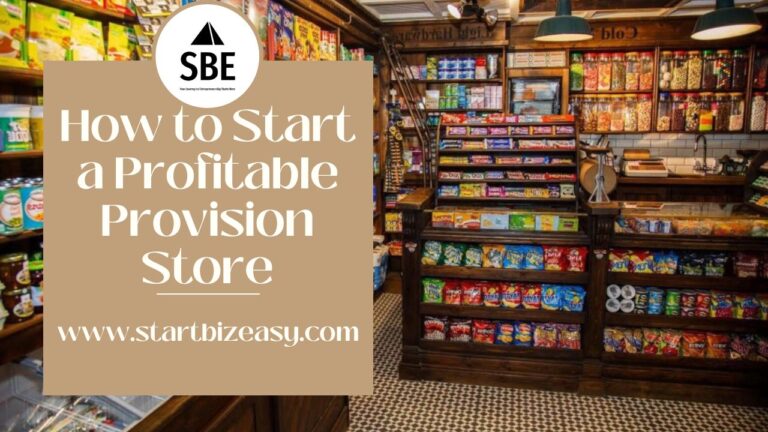
Knowing how to start a small clothing business from home can be the next big thing to happen to you if you are diligent and dedicated to your business.
Whether you’re a fashion aficionado or simply just a business person who wants to venture into the clothing business from home because for whatever reason it may, the clothing industry offers endless possibilities for creative expression and entrepreneurial success.
From designing and selling unique pieces to reaching a global audience, establishing a small clothing business can be an incredibly rewarding endeavor.
And with the convenience and flexibility of running it from home, you can turn your vision into a reality without breaking the bank or sacrificing your work-life balance.
Table of Contents
How much does it cost to start a Clothing Business from Home in Nigeria?

The initial investment required to start a small clothing business from home in Nigeria varies depending on the type of clothes you plan to sell.
If you are interested in starting a second-hand clothing business, commonly referred to as Okrika, you will need a minimum of N50,000 Naira to begin a profitable home-based clothing business.
On the other hand, if you aim to establish a business selling new clothes, you will need a minimum of 200,000 Naira to start a profitable small clothing venture from home.
Please note that these figures represent the minimum amount required and may vary based on factors such as the scale of your business, sourcing options, marketing strategies, and other related expenses.
How to Start a Small Clothing Business from Home in Nigeria

1. Define your niche
Determining the type of clothing you want to sell and identifying your target audience is a crucial step in starting a successful clothing business from home. Here’s an explanation of the factors to consider when choosing your niche;
1. Gender: Consider whether you want to cater to a specific gender or offer clothing for both men and women. This decision will influence your product range and marketing strategies.
2. Age group: Determine the age group you want to target. Clothing preferences vary among different age demographics, so understanding your target age group will help you curate designs and styles that appeal to them. Though the most patronized age group clothes are children. It doesn’t mean adult clothes don’t get patronage, it all depends on your location.
3. Style: Think about the fashion style or aesthetic you want to focus on. It could be casual, formal, trendy, vintage, bohemian, athletic, or any other specific style. This will guide your product selection and help you establish a consistent brand image.
4. Price range: Decide on the price range of your clothing items. Are you targeting budget-conscious shoppers or offering premium and high-end products? The price range will impact your sourcing decisions, marketing strategies, and target market.
By considering these factors, you can create a focused and unique brand identity. For example, if you choose to sell affordable and trendy clothing for young women, your brand identity will revolve around offering fashionable and budget-friendly options that cater to the latest trends for young women. This specificity allows you to differentiate yourself from competitors and attract a specific target audience which is better than selling generalized clothes to meet broader targets.
It is commonly said that money is important, but in business reality, choosing the right product to sell is more important than capital.
2. Conduct market research:
Researching your target market is an essential step in starting a clothing business from home. It involves gathering information about your potential customers, their preferences, buying habits, and the existing competition.
It is good to have what to sell, but terrible if you don’t understand the purchasing power of your target market.
Below are areas of focus when conducting market research on your target audience;
- Preferences:
Understanding your target market’s preferences helps you identify the types of clothing they are interested in, their preferred styles, colors, patterns, and materials. This knowledge allows you to curate a product selection that aligns with their tastes and increases the likelihood of attracting their attention and making sales.
- Buying habits:
Researching your target market’s buying habits provides insights into how and where they prefer to shop for clothing. Are they more likely to purchase online or in physical stores? Do they tend to shop during specific seasons or events? Do they prefer buying on credit rather than immediate payment? Knowing these habits helps you determine how you will manage your inventory and the most effective sales strategy to use (especially if they are credit buyers).
- Competition:
Analyzing the existing competition in the market allows you to identify gaps or opportunities that you can fill with your products. By studying your competitors, you can determine what they offer, their strengths, weaknesses, pricing strategies, and unique selling points. This knowledge helps you differentiate your brand and products. Offering something unique not only sets you apart from the competitors around your business but also forces your target market to buy from you even if they are still buying from your competitors.
- Market gaps:
It is another easy and lucrative way to penetrate into this business. By examining your target market and competitors, you can identify areas where customer needs are not being fully met or where there is a lack of options. These gaps present opportunities for you to position your products as solutions and cater to unfulfilled demands. This could involve offering clothing for underserved demographics, specific styles that are currently trending, or addressing sustainability and ethical concerns that may be lacking in the market.
By doing your research around these factors, it will be easy for you to not only penetrate into this business but also succeed in this clothing business. Remember the goal is to be unique not copycats.
3. Source your products:
When it comes to sourcing your products, it is necessary to have determined your target market preferences and purchasing power, through the market research you conducted.
If you are able to get that information, it will be easier to know which method of sourcing will be better,—whether it’s online sourcing or sourcing from local markets.
If you opt for online sourcing, you can refer to the article “How to Start a Mini Importation Business” for guidance on that particular path.
On the other hand, if you choose to source locally, it’s essential to familiarize yourself with Nigeria’s biggest markets, such as Onitsha Market and Aba Market. These markets can serve as excellent options if your goal is to sell new clothes.
However, if you’re interested in selling Okrika clothes (second-hand clothing) from home, you’ll need to establish connections with individuals involved in the Okrika business who can connect you with their suppliers.
Alternatively, you can reach out to people who import used items from abroad to sell and establish a relationship with them. This way, they can bring in clothes for you according to your specific requirements.
Please note that it’s important to conduct thorough research and ensure the legitimacy and reliability of any suppliers or individuals you engage with.
4. Set up your workspace:
When starting a clothing business from home, it’s important to designate a dedicated area specifically for your business operations.
This space will serve as your workspace and help you stay organized.
Even if you are starting with a small quantity of clothes, don’t just spread them at the front of your house, add some form of packaging to give it more value in the sights of customers.
Below is how you can effectively create the perfect workspace for your clothing business at home;
- Space allocation:
Identify an area in your home that can be solely dedicated to your clothing business. This could be a spare room (ie if the room is located close to the entrance or outside the house), a section of a larger room, or even a designated corner. The size of the space will depend on the scale of your operations and the amount of inventory you plan to store.
- Storage:
Ensure you have enough storage solutions to accommodate your inventory. Depending on the volume of clothing you plan to keep on hand, you may need racks, shelves, bins, or cabinets to store your products in an organized manner. Consider utilizing storage solutions that optimize space and keep your inventory easily accessible.
- Packaging:
Allocate space for packaging materials such as boxes, nylons, tape(for those selling personally designed clothes), labels, and any other supplies required for packaging your products. Having these materials readily available in your workspace will make you efficient when attending to customers.
- Organization and cleanliness:
Keep your workspace tidy and organized to optimize productivity and efficiency. Implement systems for inventory management, such as labeling or categorizing your products, to easily locate items when needed. Regularly clean and declutter your workspace to maintain a professional and conducive working environment.
By designating a dedicated area for your clothing business, you can separate your personal space from your work area, which helps establish a work-life balance. It also ensures that your inventory, packaging materials, and shipping supplies are easily accessible, allowing for smoother operations and faster response to customers’ needs.
5. Implement marketing strategies:
When starting a small clothing business from home, marketing is one odd piece of information you want to hear👂. But the truth is you still need to market your business.
Yes, the business is small and your target market consists of people around you, but how will they know you have started selling clothes if you don’t inform them, especially if the clothes are new clothes that come with high prices and good quality?
Word-of-mouth publicity will be okay for your small clothing business at this early stage. However, as your business grows you can incorporate selling online into the business, by leveraging on platforms like WhatsApp Business, Facebook Page, and Instagram Business accounts to expand your reach.
When catering to online customers, you don’t need to target the entire country unless you have grown significantly and can handle such a high volume of traffic. In the beginning, it’s advisable to focus on targeting your city or state.
Remember, only market what you have, not what you are expecting or don’t have in stock. That way you get to build trust with customers.
6. Monitor and adapt:
Continuously assessing your clothing business’s performance, tracking sales, and gathering customer feedback is crucial for its growth and success.
You can efficiently achieve this by focusing on key areas such as;
- Evaluating business overall performance in terms of revenue generated and expenses incurred so far.
- Sales recording or tracking; It aids in making informed decisions regarding inventory management, especially in areas of identifying which items to invest in more, and the items to never restock anymore.
- Customer feedback; Only Pay attention to relevant comments, suggestions, and concerns. But the irrelevant feedback should also be pondered on before you conclude that it is irrelevant.
- Market trends and competition analysis: Stay informed about market trends and keep an eye on your competitors. -Let the eyes be good ones though lol
- Adaptation and improvement are necessary after you have gathered this whole information.
Adapting your strategies based on these insights helps refine your products, enhance customer satisfaction, and stay ahead in a competitive market. Embrace a proactive and customer-centric mindset to continuously evolve and grow your clothing business.
READ ALSO:
- How to Start a Tshirt Business
- From Concept to Success: How to Start a Clothing Business
- How to Start a Successful Recharge Card Printing Business
- How to Start POS Business in Nigeria: Easy Guide
- Best 18 Small Business Ideas from Home
Final Thoughts on Starting Your Small Clothing Business from Home in Nigeria
Starting a clothing business requires dedication, creativity, and hard work. Stay focused on your goals, provide high-quality products, and deliver exceptional customer experiences to increase your chances of success.
If you have any questions or contributions, please leave them in the comment section below.
Remember to turn on the Bell 🔔 Notification icon to get updated on your device when new articles are published
Discover more from StartBizEasy
Subscribe to get the latest posts to your email.





